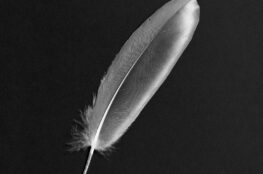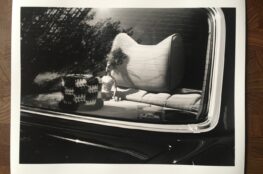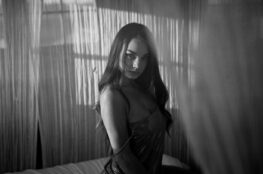The english version can be found here.
Eric Antoine ist eines meiner großen Vorbilder und für mein Interesse an der analogen Fotografie verantwortlich. Es waren seine Bilder in Skateboardmagazinen die mich begeisterten. Doch die Zeiten ändern sich und nicht nur Eric Antoine sondern auch seine Arbeiten sind erwachsener und tiefgreifender geworden. Mich hauen sie noch immer von den Socken und umso begeisterter war ich, dass er sich trotz der Arbeit an seiner neuen Webseite die Zeit für mich genommen hat. Viel Spaß mit dem Interview.
Hallo Eric, erzähle uns doch kurz etwas über dich.
Ich lebe in Frankreich nahe der deutschen Grenze und bin 42 Jahre alt.
Was beschäftigt dich aktuell?
In letzter Zeit fahre ich viel Ski und schaue Filme an. Außerdem bereite ich meine neuen Bilder vor. Ich möchte diese dann zwischen Mitte März und Oktober erstellen. Im Winter arbeite ich nämlich mehr an Ideen und experimentiere. Ich versuche für eine Zeit keine Bilder zu machen um mich nicht an der Fotografie aufzureiben.
Wie hat es bei dir mit der Fotografie begonnen?
Ich habe relativ früh mit einer mittelmäßigen Kamera Bilder von meinen Freunden und Freundinnen gemacht. Mitte der 90er Jahre habe ich dann mit dem Entwickeln und Printen begonnen und seither auch damit nicht mehr aufgehört. Ich hatte schon viele Kameras und habe viel experimentiert.
Ich habe deinen Namen das erste Mal etwa 2003 gelesen als ich mein erstes Skateboardmagazin in den Händen hielt. Wenn ich mir jetzt deine Arbeiten ansehe gibt es keinen Hinweis mehr auf die „wilden“ Zeiten als Skate-Fotograf. Wie ist das passiert?
Ich bin mein ganzes Leben Skateboard gefahren und fahre auch jetzt noch. Es hat mich dazu gebracht, viel zu reisen und war für etwa 15 Jahre meine Arbeit und sicherte mein Überleben. Ich habe schon früh nebenher mit Kunstprojekten begonnen, sie aber niemandem gezeigt. 2010 habe ich dann aufgehört für diverse Marken und Magazine zu arbeiten um mich nur auf meine Kunst zu konzentrieren. Natürlich gibt es noch Spuren dieser Vergangenheit, nämlich etwa 5000 Seiten in Magazinen und wahrscheinlich noch viele, viele Bilder.
Was ist jetzt die Philosophie hinter deinen Bildern?
Nun ja, ich nehme außer Landschaften nicht viele Bilder auf. Meistens überlege ich mir vorher einen Aufbau und zeichne diesen dann auch bevor ich überhaupt mit meiner Kamera losziehe. Es braucht also viel Zeit und ich denke, dass ich auch nicht so viele gute Ideen habe. Ich schieße auf vielen verschiedenen Formaten, aber am Meisten Spaß macht mir die Arbeit mit großformatigen Kollodium-Nassplatten. Ich lasse es ruhig angehen und nehme etwa ein oder zwei Bilder am Tag auf. Ich will nicht mehr Bilder machen und generell möchte ich nicht jeden Tag oder zu jeder Jahreszeit fotografieren. Außerdem schaue ich mir generell wenige Fotografien an, ich finde meine Inspiration in Filmen und der Natur. Ich lebe in einem Wald in den Bergen. Hier gibt es nicht viel zu sehen, und das ist genau das was ich aktuell brauche. Weniger sehen, der Herr über meine eigenen Bilder und Ideen sein, sich auf einfache Dinge fokussieren und sie auf meine Art präsentieren.
Auf deiner Homepage steht, dass die Bilder deiner letzten Serie „ensemble seul“ im Umkreis von 100 Meter um dein Bett aufgenommen worden. Kannst du uns dieses Konzept erklären?
Zwischen 2010 und 2014 habe ich mich auf die Arbeit an „ensemble seul“ und dem daraus entstandenen Buch konzentriert. Der Fokus lag auf meinem Haus, jedes Bild wurde maximal 100 Meter außerhalb des Schlafzimmers aufgenommen. Es war wegen der Einschränkungen die der Nassplattenprozess mit sich bringt eine gute Übung für mich. Ich wollte außerdem lernen, wie man die Welt ohne einen wirklichen Zugang dazu präsentieren kann. Es zwang mich dazu, Symbole und Bilder zu nutzen, ich musste neue Ideen finden und mich intensiver mit Plätzen und Objekten befassen. Irgendwie konnte ich kein gutes Motiv finden, aber ich war begeistert von den neuen Dingen die vorher für mich keine Bedeutung hatten und nicht „universell“ genug waren. Ich habe also mein Augenmerk auf Dinge gelegt, die die einfachen und universellen Aspekte unseres Lebens zeigen.
 Welches Equipment benutzt du am liebsten?
Welches Equipment benutzt du am liebsten?
Ich nutze viele verschiedene Kameras, Objektive und Formate. Mein genereller Liebling ist meine Nikon FM2 und meine Pentax Asahi 6×7. In den letzten Jahren habe ich sie allerdings weniger genutzt da ich mehr in den Formaten 24x30cm, 30x40cm oder 40x50cm gearbeitet habe. Dazu waren verschiedene Kameras aus dem 19ten Jahrhundert im Einsatz die ich gesammelt und nach meinen Bedürfnissen repariert habe. Kürzlich konnte zusammen mit Gibellini mit einer extra für 40x50cm Nassplatten umbauten Kamera arbeiten. Er stellte einen Prototypen her den ich testete, dann überarbeitete er viele der Funktionen um sie so gut wie möglich zu machen. Ich denke diese Kamera ist die, die ich aktuell am Häufigsten benutze.
 Woher kommt deine Inspiration?
Woher kommt deine Inspiration?
Ich sehe die Dinge um mich herum. Ich grabe in meiner Erinnerung und meiner „Model-Erinnerung“. Ich spaziere viel in den Wäldern. Ich sehe mir viele Filme und Gemälde an. Ich lese etwas. Das reicht mir aus.
Was wäre dein Traumprojekt?
Ich lebe es gerade, mehr brauche ich nicht. Trotzdem würde mich ein leeres Gebäude oder ein leeres Haus für mein Labor und meine Experimente sicher nicht stören. Das muss ich noch finden.
 Gibt es eine Liebe neben der Fotografie für dich?
Gibt es eine Liebe neben der Fotografie für dich?
Ich mag die Fotografie, aber ich denke nicht, dass ich sie liebe. Ich nutze sie in meiner Arbeit, denn ich habe einen Prozess gefunden der mich bei den Bildern und Abzügen nicht einschränkt. Ich mache gerne Objekte aus Fotografien und arbeite gerne mit Holz, auch wenn ich hier nicht so talentiert bin. Ich hatte den Traum ein Maler zu werden, aber da ich nicht malen kann bin ich jetzt ein Fotograf…. Ich liebe das Kino und würde sehr gerne einen eigenen Film drehen. Außerdem liebe ich es gerade, dass ich um mein Haus herum Skifahren und wandern kann. Mir macht es Spaß zu kochen und natürlich das Skateboarden. Auch nach 28 Jahren hat sich hieran nichts geändert!
Was ist der größte Mythos wenn es um Kollodium-Nassplatten und analoge Fotografie geht?
Der Gedanke, deine Bilder wären dadurch interessanter. Sie sind es nicht.
 Etwas philosophisch gefragt: Wann wird etwas zu einer Fotografie? Passiert es in der Kamera, bei der Entwicklung oder bei der Herstellung des Abzugs?
Etwas philosophisch gefragt: Wann wird etwas zu einer Fotografie? Passiert es in der Kamera, bei der Entwicklung oder bei der Herstellung des Abzugs?
Ein Foto ist ein Foto. Jedes Foto. Ich habe damit begonnen meine iPhone Bilder zu drucken da ich damit die meisten Bilder aufnehme und die Qualität mittlerweile gut genug ist. Wenn du den Auslöser abdrückst und etwas erscheint ist es ein Foto.
Eigentlich braucht man nicht mal eine Kamera für ein Foto. Photosensitivität ist eine wunderbare Sache und damit zu spielen ist ein Geschenk. Eine Schere, ein Blatt buntes Papier und nach einer Woche in der Sonne ist es ein fotografischer Abzug. Wir haben das alle schon erlebt, wir nehmen alle Fotos auf. Jeder ist ein Fotograf. Digitale Fotografie hat diesen Bereich für fast jeden zugänglich gemacht. Ich mag es digitale Farbbilder zu schießen. Ich denke wir sollten uns lieber fragen „Wann wird ein Foto zu einem künstlerisch wertvollen Foto?“ auch wenn das schwer zu beantworten ist. Ich werde es also nicht versuchen. Dennoch denke ich, dass sich Leute diese Frage öfter stellen sollten bevor sie ihre Bilder zeigen. Auch wenn jeder ein Fotograf ist gibt es dennoch wenig Bildung in der Fotografie. Viele Leute wissen nicht einmal was, warum oder wie etwas funktioniert oder was gut ist und was nicht. Man sieht jeden Tag schreckliche Bilder in Magazinen, Zeitungen und der Werbung. Genau darum verschwindet die Fotografie als professioneller Beruf gerade.
Was wäre dein Ratschlag für angehende Fotografen die sich für den Kollodium-Prozess interessiere?
Fangt nicht damit an und wenn ihr euch doch dazu entscheidet, dann zeigt eure Bilder nicht bevor sie mehr als nur ein technischer Erfolg nach eurer Meinung sind. Denkt global, an die Geschichte der Fotografie, an die Welt der tatsächlichen Kunst und nutzt euren Verstand. Fragt euch, ob das Bild bereit ist gezeigt zu werden. Es wird immer einen oder auch tausend Menschen geben die eure Arbeit gut oder interessant finden, unabhängig davon was du eigentlich machst oder zeigst. Viele fotografieren um Likes auf sozialen Medien oder Anerkennung im Beruf zu bekommen. Für diese Leute ist mein Ratschlag: Hört auf damit oder beschäftigt euch tiefgreifender mit eurer „Arbeit“- Einige sehr sehr schlechte Bilder die mit alten Techniken aufgenommen wurden sind weltweit in sehr bekannten Magazinen gezeigt worden. Es waren wirklich sehr schlechte amateurhafte Aufnahmen bei denen das Bild kaum erkannt werden konnte. Für mich fühlt sich das in etwa so an: Stellt euch ein Welt vor, in der niemand bisher ein Klavier gehört hat. Plötzlich käme eine Person und würde ein sehr sehr schlechtes Stück auf dem Klavier spielen und jeder würde applaudieren. Es ist also eine Art Bildungslücke in einem bestimmten Bereich. Wenn mehr Menschen diese alten Techniken benutzen würden wären weniger Menschen so begeistert und entzückt von jedem beschissenen Bild das so aufgenommen wurde. Der „Mainstream“ Konsument der Fotografie ist also in diesem Bereich einfach zu wenig gebildet. Das ist aber nicht die Schuld der Person die die Bilder sieht, sondern die Schuld der Fotografen die zu ungeduldig sind und ihre Bilder zu schnell in die Welt schleudern.
Gibt es noch eine Frage, die du schon immer in einem Interview gestellt bekommen wolltest?
Mir fällt gerade keine ein. Eigentlich bin ich auch besser darin Fragen zu stellen als sie zu beantworten.
Gibt es noch letzte Worte vor dem Abschluss des Interviews?
Ich denke ich kann mich nur für eure Zeit bedanken und wünsche viel Erfolg bei der Übersetzung ins Deutsche!
Mehr von Eric Antoine gibt es auf seiner neu gestalteten Homepage oder seiner Facebook-Seite.
Eric Antoine is one of my heroes and the reason why I started shooting more analog photos. His skateboarding photos amazed me. But time has passend and Eric and his pictures seem to have grown up and became deeper. They still baffle me, and I was more than happy, once Eric told me that he found the time to answer my question even though he currently works on his new website. Enjoy the interview. 
 Is there any advice you could give to aspiring photographers thinking about starting to shoot wet plates?
Is there any advice you could give to aspiring photographers thinking about starting to shoot wet plates?





